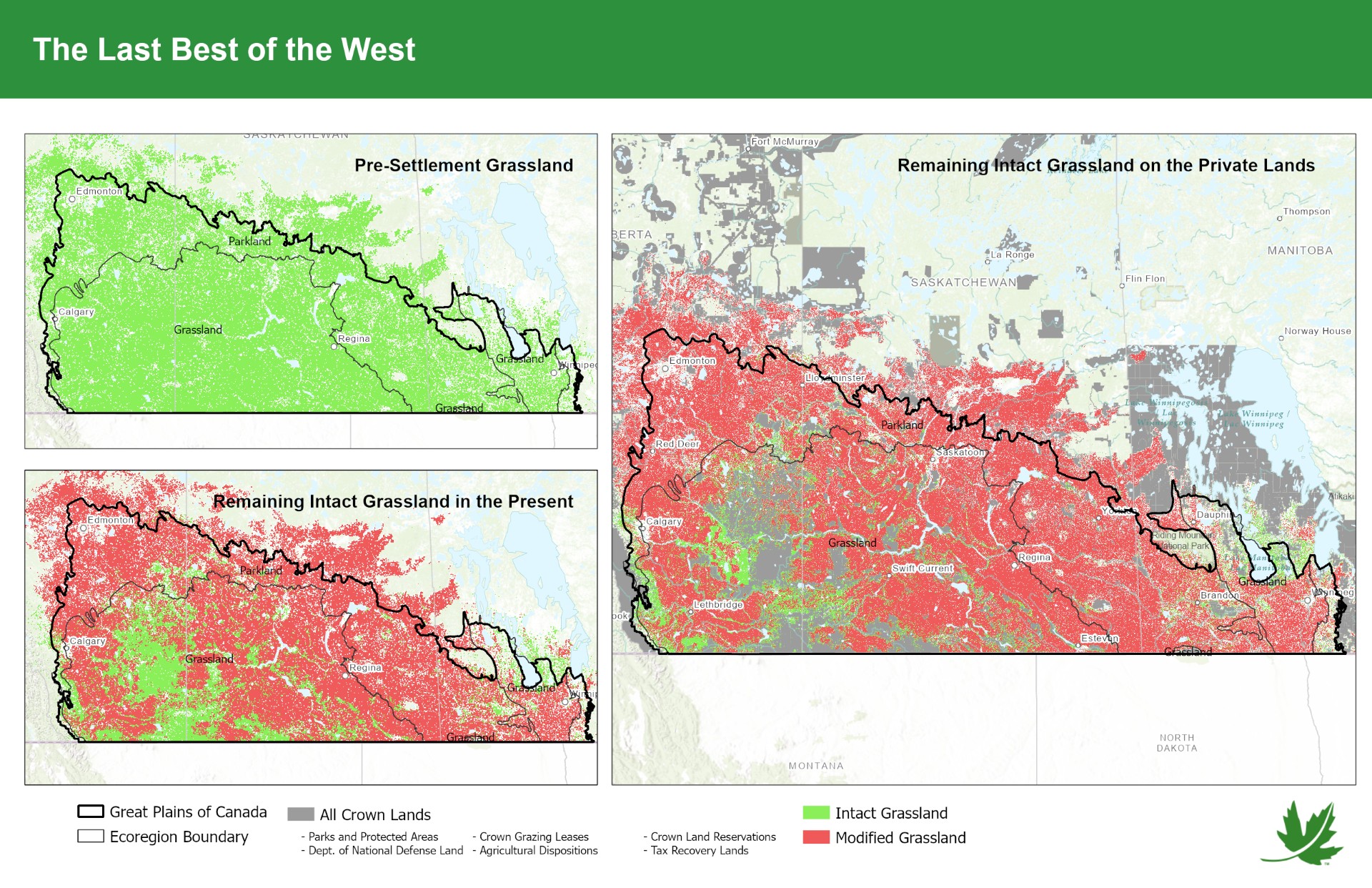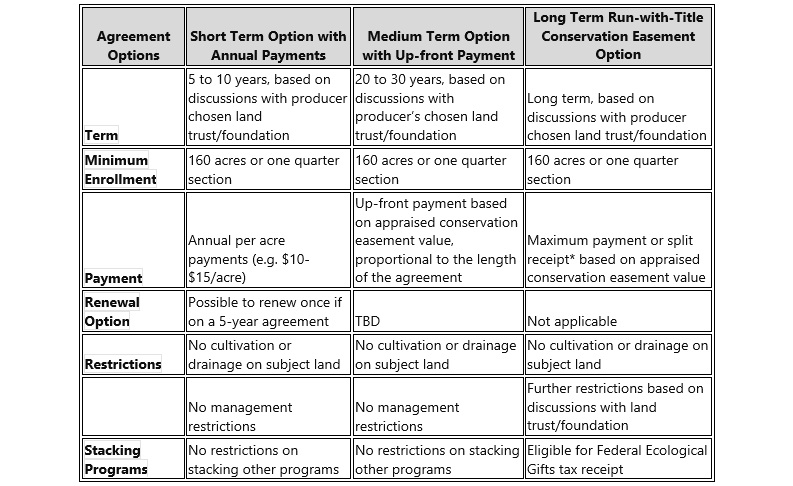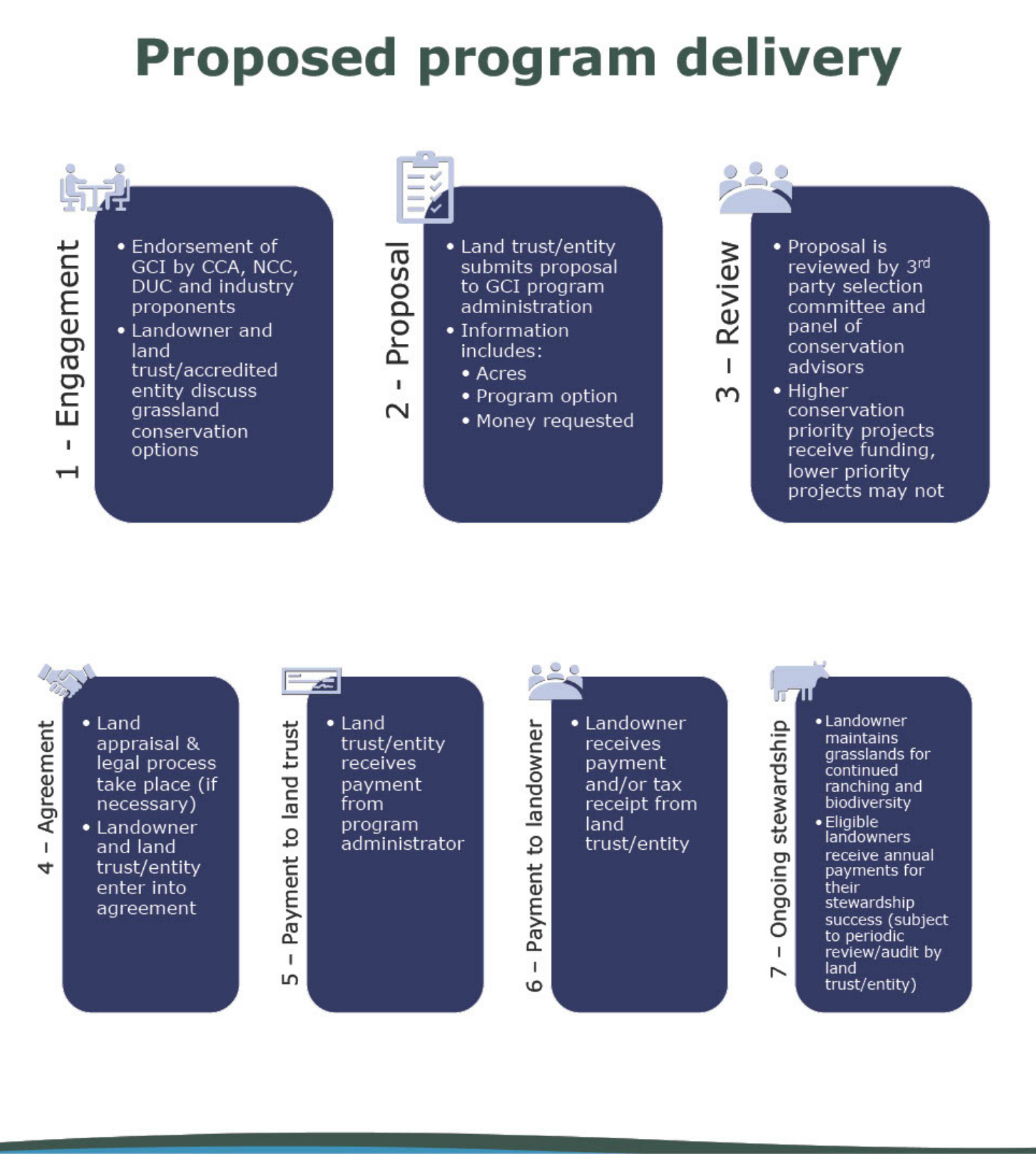Grasslands Conservation Initiative (GCI)
OVERVIEW
The GCI is a proposed producer-initiated program led by the Canadian Cattle Association with the endorsement of Canada’s leading conservation and producer organizations to develop a host of solutions where conservation and stewardship of Canada’s native prairie grasslands provides an economic and intergenerational benefit to ranchers.
The Challenge
- Grasslands are one of the most threatened ecosystems in the world. In Canada, approximately 82% of our native prairie grasslands have been lost since the last prairie treaty was signed in 1877 (see Figure 1). These grassland landscapes are also home to some of Canada’s most endangered species.
- When native grasslands are converted, not only do we lose ecosystem function, biodiversity, and wildlife habitat, we also lose considerable amounts of stored soil carbon which is released into the atmosphere (up to 50% in some soils, or up to 100 Tonnes of carbon per acre). Once converted, restoration of native prairie is extremely difficult and expensive.
- Grasslands and pasture are also the foundation of the livestock industry where producers steward these lands for positive conservation and ecosystem services essential for healthy biodiversity.
- When grasslands are converted we also lose a critical element of our economic ranching model since the greatest conversion rate is on privately owned native grasslands used for sustainable ranching.
- Environmental land trusts like Ducks Unlimited Canada (DUC) and the Nature Conservancy of Canada (NCC) share our interests in conserving grasslands and have conserved some of Canada’s wetlands and native grasslands. However, only about 6% of the remaining native grasslands are considered under conservation.
- To conserve the grasslands that remain, and the grazing land base that supports our industry, Canada will have to incentivize private stewardship and management strategically and significantly as well as invest in conserving livestock operations who steward these natural grasslands in Canada.
- To halt the rate of conversion and conserve what remains of Canada’s prairie wetlands and grasslands will require a whole of society approach where governments, ENGOs, livestock ranchers and landowners, individual and corporate donors will be needed.
- Approximately 32% of the remaining prairie grasslands are under private land ownership, therefore private stewardship and management needs to be strategically and significantly invested in.
- Financial support for ranchers through conservation incentives will help to alleviate the significant economic pressures to convert grasslands to cultivation.

Figure 1: Human altered landscape and remaining intact grasslands in Prairie Canada (map by NCC)
Environmental Impacts and Considerations
- Industry Environmental Goals: The Canadian beef sector continues to be a leader in agriculture sustainability and the Canadian Beef Advisors have created ambitious ten-year goals leading to 2030. Land use and biodiversity are strong themes across these 2030 industry goals.
- Our 2030 goal focuses on no net loss of native prairie grasslands, and to ensure the remaining 18% of native prairie remains intact. This will help to maintain and enhance the existing wildlife habitat capacity within agricultural lands managed by livestock farmers and ranchers.
- Land Use and Conservation: The conservation of remaining native grasslands through this initiative will not only benefit farms and ranches and intergenerational transfer of these operations but can help support achieving many national and international conservation goals by 2030.
- Biodiversity Enhancement: The recorded grassland conversion trend that has been occurring since approximately 1941 has resulted in an ever-expanding list of species at risk being identified in Canada’s prairie grasslands.
- The efforts of the GCI supports the goal to halt and reverse biodiversity loss.
- The recently released 2024 National Beef Sustainability Assessment & Strategy identifies that land used for beef production contributes the majority of critical habitat that wildlife needs for both reproduction (74 per cent) and feeding (55 per cent) when all of Canada’s crop and pastureland is considered. Despite an overall loss of wildlife habitat on Canada’s pasture and cropland, beef’s share within what remains has increased, demonstrating the importance of beef production in keeping these areas intact.
- In conjunction, GCI can benefit farmers and ranchers by providing programs geared to improve revenues generated off their privately held native grasslands and support the intergeneration transfer of these operations to future generations and keep grazers on these landscapes.
Proposed Project Details
Recommendation:
- The Canadian Cattle Association (CCA), with endorsement by NCC and DUC, have identified a suite of solutions to help ranchers benefit from the conservation of one of the most threatened ecosystems in the world—native grasslands.
- The GCI project will bring a win-win-win solution to protect grasslands and the many benefits they bring to Canada’s environment, while ensuring livestock farmers and ranchers with privately held native grasslands can continue to operate their businesses in a financially sustainable manner.
- Landowners would work with any land trust, foundation, or approved delivery partner they so choose.
- CCA is seeking to partner with Agriculture and Agri-Food Canada (AAFC), Environment and Climate Change Canada (ECCC) as well as other industry, private, and philanthropic investors, and livestock producers (e.g., beef cattle, bison, equine, ovine etc.) to conserve grasslands. The outcome will lead to sustainable growth for agriculture while effectively stewarding the environment.
- CCA and our endorsers have developed five basic conservation programmatic elements as part of the GCI to provide flexibility and options to livestock operators to make the best financial and sustainable choice for both their business and for their conservation efforts. CCA envisions government financial support for a five-year pilot project.
• The proposed structure of the program is a multi-pronged approach designed to:
o Make conservation of native grassland habitats through voluntary short-term, medium- term, and permanent agreements or easements on privately owned livestock grazing operations a financially attractive and beneficial decision.
o Provide additional revenue for stewardship and ecosystem service delivery from native grassland habitats on privately owned ranching/livestock grazing operations.
o Be an opportunity for blended finance by private, philanthropic, and public investment delivering both shared and individual interests.
Proposed GCI voluntary agreement options:

* Split receipting is when a long-term agreement includes a partial cash payment and the remaining value donated by the landowner, and where they receive a combination of cash and a charitable tax receipt to apply against future income.
Additional Elements of GCI Proposal:
The following elements remain in development stage but are proposed as additional incentive options to those who hold medium term or run-with-title agreements (not available to short term agreement participants):
- Ecological Goods and Services (EG&S) Management Fund for sustaining native grasslands:
Under this additional element it is proposed that a portion of the funds for each of the medium and run-with-title agreements signed would be invested into an EG&S endowment fund. Other contributions could come into the fund via philanthropic entities, conservation funds and more. As the fund builds through investments, on a timed basis, producers signed onto the GCI medium and run-with-title options would be eligible for top-up payments based on their native grassland stewardship and management efforts and related improvements in their grassland habitat.
- Preferred financing opportunities for participants in GCI and similar programs:
This proposal seeks to work with lending partner(s) toward developing low-interest long-term (25-year plus) loans for producers, particularly young producers, who have an existing agreement in place with GCI and want to purchase additional native grasslands for their operation.
Program Proposed Administration:
A yet-to-be-determined semi-independent administrative body overseen by the CCA would deliver the GCI and an expert panel would select applications based on merit and risk level of conversion among other criteria. And it is important to note that the options laid out above are examples and other novel incentivizing options for grassland conservation should be considered going forward.
CCA and our conservation colleagues seek a partnering approach with federal funding for a five-year GCI pilot to achieve a conservation rate of 148,000 acres per year of privately held native grasslands protection across Manitoba, Saskatchewan, Alberta, and B.C. If successful, the pilot would prevent the conversion of 750,000 acres of native grasslands across the five-year pilot.
While the GCI is focused on the threatened native grassland ecosystems of the western prairie landscapes, a stage two of the initiative, currently in the conceptual phase, would seek a similar program focused on permanent tame mixed grass/legume pasturelands, forests and wetlands across Canada. Long-standing pasturelands from east to west provide important wildlife habitat and contribute to enhanced biodiversity and soil health.

Frequently Asked Questions
What is the GCI and what is its intended purpose and outcomes?
The GCI is a proposed program led by the CCA in partnership with Canada’s leading conservation and producer organizations wishing to develop a solution where conservation and stewardship of Canada’s native prairie grasslands provides an economic benefit to ranchers. Good stewardship practices on working landscapes and ranches should be rewarded for the maintenance of critical habitat and ecosystem services that grasslands provide. This program is designed to help conserve our remaining intact grasslands by supporting good stewardship practices that maintain the health and productivity of the wetlands and native grasslands across western Canada.
Is any part of the GCI program mandatory?
No, becoming involved in GCI is completely voluntary.
Do I have to work with a specific conservation organization under the GCI program?
No, participating ranchers can choose which GCI delivery partner they prefer to work with.
Is this a ranch land purchase program?
No, there is no purchase of lands by any delivery partner/conservation organization under the GCI, all lands will remain owned by producers. The program currently proposes to utilize diverse mechanisms to provide flexible options for ranchers to participate. The primary mechanism of GCI is to address the conversion of grassland with conservation agreements of varying lengths, including:
1) short-term conservation agreements/contracts of perhaps 5 to 10 years,
2) medium-term agreements of 20-30 years, and
3) a run-with-title agreement option.
Under all the options, participants receive payments to maintain native grasslands and wetlands intact (no cultivation or wetland drainage for the duration of term). It is important to note that the terms and mechanisms contained in GCI are still under development, and we continue to seek input from all stakeholders to ensure the program is effective and equitable.
Are there any management restrictions placed on participating ranches?
For the short- and medium-term options there will be no prescribed management restrictions other than no breaking (cultivating) of existing intact ecosystems (such as cultivation of grassland or drainage of wetlands) on the subject land parcel(s) for the length of the term agreement. Note that these agreements will still require a legal contract outlining the conditions of the payments received. Under the run-with-title option there may be management restrictions based on discussions between the landowners and the accredited conservation organization they choose to work with.
What is the minimum amount of land I can enroll in the GCI?
For all the options, the minimum land parcel to qualify will be 160 acres (one quarter section) although partial quarters within part of a larger proposal can be included.
Will participation in GCI impact my ability to access other future incentive programs?
The GCI short and medium-term options have no restrictions on a producer accessing or ‘stacking’ other programs that could be beneficial to their bottom line and if entering such programs does not result in cultivation or drainage on subject native grassland parcel(s) for the duration of the term agreement.
Can I move from one option to another during the term?
Yes, if a landowner has entered a short-term or medium-term agreement, they can at any time choose to move to a longer-term option. For a short-term that could be moving to a medium-term or run-with-title agreement. For a medium-term agreement, the landowner could only opt to enter a run-with-title agreement.
What are the payments for each of the term and run with title options?
The specific payments and delivery mechanisms for the conservation agreements are still under development, but the goal of GCI will be to provide flexible and fair options to participating landowners that vary based on the commitment term. Currently the short-term conservation agreement is expected to be a flat rate paid per acre annually at a consistent value regardless of location Compensation for medium and run-with-title agreements will be based off the appraised conservation easement value of the land, proportional to the term length of the agreement. Since the medium-term and run-with-title options would be based off the appraised conservation easement value, individual compensation rates will vary depending on the land location and land values in that area. The compensation rates and agreement restrictions for the medium-term and run-with-title options may also be informed by risk of conversion and other ecological factors, project demand, and the organization who will deliver the term agreement with landowners. It is important to note that all mechanisms and payment schedules for this program are actively under development, and CCA continues to engage our members regarding what terms and conditions are desired in this program. It will be important to ensure that the mechanisms deployed by GCI are complementary, accessible, and realistically valuable to all producers interested in participating.
Where appraisals are required, who covers the cost of those appraisals?
The costs of appraisals will be covered by the funded program and paid through the approved trust of foundation the landowner is working with.
Is the GCI only available in the prairie grassland regions?
Presently, yes, the focus is on conserving the loss of native grasslands in the prairies and into BC. However, early planning has begun on a phase two GCI concept that would be applicable to permanent tame pasturelands across Canada as these habitats can be critical to ecosystem function, soil health, at-risk species and overall biodiversity health.
Are there any other financial benefits possible under the GCI program?
We are recommending that an “Ecosystem Goods & Services” fund be created as part of the GCI program. This fund could function to provide annual support payments for participating ranches for positive native grassland and wetland stewardship and/or stewardship actions taken by a ranch to advance a particular conservation goal. We are also exploring the opportunity to provide low-interest long-term loans for producers, particularly young producers, who have an existing agreement in place with GCI to purchase additional grasslands for their operation.
Who or what will run this GCI program?
A semi-independent administrative body referred to as the GCI Program Administrator would operate the GCI overseen by the CCA with CCA having financial controls.
How would the administrators decide on who gets funded?
Unless the need to meet more frequently arises, Program Administrators would assemble conservation specialists bi-annually to review proposals and select projects based upon funding availability and merit. Applications for funding would be evaluated based on several factors, including the risk of ecosystem conversion and the conservation value of the land. As noted, independent appraisals would be required under the medium- and long-term agreements to determine the agreement value.
The primary focus of GCI is to provide an economic benefit for ranchers who conserve and steward wetlands and native grassland. When an application is submitted to the GCI administrator, it is expected that the project selection committee will be more likely to select projects for funding that have a high proportion of wetland and native grasslands included in the proposal.
It is possible that the restoration of endangered grassland/wetland ecosystems might receive more attention in future GCI proposals.
Under the short- and medium-term options, what happens if I sell the enrolled parcel of land before the term runs out?
While terms and conditions remain under consideration, the intent for the short-term option, because the payments are annual, payments would cease, and the new owner has no obligations.
Under the medium-term option, a caveat must be placed on title for the specific parcel of land stipulating there can be no conversion of wetlands and native grasslands on the subject parcel(s) for the duration of the agreement.
Run-with-title agreements will transfer with the land at time of sale, meaning that the restrictions are registered on title and will run with title from owner to owner.
Will term conservation agreements have an impact on local land and land rental values?
Specialists contracted by the CCA and SSGA have conducted research into deployment of similar programming in other countries and jurisdictions, and we are confident that the mechanisms being developed within GCI will not negatively impact local land markets. For example, experiences in the US following the introduction of term conservation easements demonstrated no impacts on land or land rental rates. In Manitoba, evidence suggests that local land values and rental rates decreased or had no change following conservation agreement implementation. This research is ongoing, and these considerations will continue inform the design of the GCI program proposal.
What is the definition of native grasslands under GCI?
The basic answer is that native grasslands = grasslands that have never been cultivated. There can be allowance for existence of some tame species presence in the subject parcel(s) (CCA continues to engage our members on this definition).
Questions / Comments
If you have any questions or comments, please email grasslands@cattle.ca